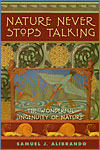
One of my favorite verses of poetry is from British poet William Blake. His awe of nature is revealed in these oft-quoted lines:
To see a world in a grain of sand
And heaven in a wild flower
Hold infinity in the palm of your hand
And eternity in an hour.
(from ‘Auguries of Innocence’)
There are many ways that parents can teach children about our God the Creator, but one of the best ways is through studying the natural world together. It’s not hard for me to have a child-like curiosity of the outdoors because I’m discovering everything fresh and new as an adult.
I was happy to receive Samuel Alibrando’s book, Nature Never Stops Talking, from Mind & Media. I love the colorful artwork on the cover, and I appreciate Mr. Alibrando’s fresh approach at discovering the natural world. He began his writing career as a father, while teaching his children. “I enjoyed pointing out certain things to my children (now fully grown),” he says in the introduction. “Most often I would pull a leaf off a tree and say, ‘This was an idea before it was created. We can physically touch what was once an idea.'”
Although Alibrando admits that he hasn’t finished college (remaining only a few credits shy of an AA degree), his hunger for understanding details about nature set him off on a quest of self-discovery in his 30s. He later became a columnist in a local newspaper, Mountain Press, where he has been writing for at least a decade. His book, Nature Never Stops Talking, is a compilation of 100 of his best short essays, celebrating Intelligent Design.
The book is divided into easy-to-browse topics: earth and space, scientific properties, the small stuff, beginnings, plants and trees, insects, specific creatures, DNA, the human body, and another section of miscellaneous essays. The author says, “The articles are like friendly talks ‘on the porch’ with company visiting.” Interspersed throughout the book are also rules and laws that he calls “Alibrando’s Laws.” The book concludes with an appendix that summarizes these laws.
There are several articles in the book that I really enjoyed, taken in a stand-alone way. His essay on snowflakes is full of poetic wonder: “The acoustics of a sky filled with feathery flakes creates a sacred quiet.” Then he launches into a brief discussion of how snow is really composed of ice crystals, which are tiny, light-reactive prisms.
His column on pinecones was also interesting; I’ll never look at a pinecone the same way. Children will also enjoy hearing his descriptions of animals, such as his article on bats: “The smallest bat in the world is the bumblebee bat. It weighs less than a penny.”
I encourage you to visit the author’s website and blog for further discussion. He seems to be a very approachable person, interested in receiving feedback from his readers. And that’s the point of writing for many of us — we want to build a community of fellow readers.
Yet, I must be honest and say that there was an overall tone to the book which bothered me. In general, I feel that Alibrando has an “us against them” view of scientists, which I don’t understand. There are thousands of very intelligent people who further their educations into specialized fields of science, while remaining strong in their Christian faith. In fact, for many of these scientists, they develop an even more intense appreciation of God as they realize how magnificent and complex His designs are.
So it bothered me that Alibrando seemed to assume throughout the book that scientists and their so-called laws and theories are wrong; and those of us who believe in a Creator are right. On p. 51 of the book, he writes, “We start believing that scientists can do anything. But guess what? They can’t make a tree. They can’t make a flower. They can’t even make a single seed…and they can’t make stuff grow…And you thought they could do anything. Ha.”
And on p. 139, I was quite surprised this made it through editing: “If all the greatest scientific minds can’t answer these questions now, who or what put it together when it was invented, something without brains, a roll of the dice or somebody smart? You have a brain pick your favorite from those three.” (That last sentence cannot possibly have been seen by an editor.)
After a while, I found the tone of the book to be haughty — instead of inspiring me to a deeper love and appreciation for God, I felt like the author kept reminding me how smart he is — and how dumb the rest of the scientific community is. Yet children who excel in mathematics and science will someday become our future engineers, biologists, astronomers, zoologists, and physicians. To me, having a book like this discourages children from pursuing advanced degrees that would someday label them as “scientists.”
I have agonized for weeks over this review because I know the author worked hard writing his columns and compiling them into a book. He sent Mind & Media reviewers a nice letter along with his book, and I always want to encourage people who are writers to keep it up! I thought about focusing only on the positives in my review — but then I felt like I needed to be honest.
Our world is in desperate need of men and women who are well educated, passionate about their subject fields, and also strong in their Christian faith. They’ll be leading the way for the next century of discoveries. I thank God for the many scientists who labored years and years through school to acquire the credentials required to be “experts.”
(This book was given to me for review from Mind & Media as a gift from the publisher.)






One Response to Nature Never Stops Talking